WWII Service Time Line
Home Page
This is dedicated to my Dad & all the men that served with him and kept him safe.
If you remember "Angel" or the ships he
served on
Please contact us
![]() Site has been updated on
01/24/19 with
new information on the SC-1335
Site has been updated on
01/24/19 with
new information on the SC-1335
and ![]() 02/01/19 Diesel
Training School in Richmond, VA coming soon
02/01/19 Diesel
Training School in Richmond, VA coming soon

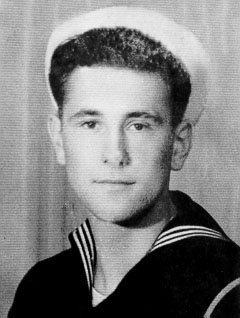
Taken in
Casablanca, French Morocco 1943
Robert J. Angell
"Bob"
Significant Duty Stations
SC-1335 & SC-516
USS Albemarle AV-5
USS Naubuc AN-84
Significant Awards
American Campaign Medal
European African Middle Eastern Campaign Metals
Asiatic Pacific Campaign Medal
Rate / Rank
MOMM1
Affiliations
Life time member of the following
The Sampson Museum
Veterans of Foreign Wars
WWII Memorial (The Lone Sailor)
Most all the pictures were taken with my Father's camera
Credit is given when we could for all others.
As he remembers it.
Chapter #1
Patriotism, honor and duty to country is what inspired me. It was a different time. We were at war. Just about everyone enlisted. My first choice was to join the Marines. They were not taking any new recruits that day. I decided to head over to the Naval Recruiting Station and on January 19,1943, 2 months and one day shy of turning 19
I enlisted in the US Navy.
I lived within the city limits of Albany, NY, so the recruiting officer allowed me to go home for the night. The rest of the guys stayed at the YMCA on So. Pearl St. I returned in the morning. They marched us down to the train station and we were on our way.
Boot camp was at the Sampson Naval Base near Auburn, NY.
Sampson is located in the heart of the Finger lakes region on Lake Seneca. I remember it being bitter cold that winter.
The first thing we did when we arrived is undress for a physical. Everything we wore or brought with us was put into a box and mailed home. We were allowed to keep our shaving gear and a few personal items. The Navy would supply us with the rest. From our sea bag to our underwear was Navy issue.
Uniforms were not handed out with any regard to size. We ended up switching with each other to find one that fit. We then stenciled our name's on everything for identification. It would be the only way to tell what was yours when they hung on the clothesline.
In the 7th week of an 8 week boot camp I came down with scarlet fever and had to be hospitalized. I am not really sure how long I was in the hospital. It might have been several weeks. When I recovered my class had long since moved on. I have no idea what happened to any of them. I was assigned to a new company of men to finish up basic training.
The Navy decided to send me to Diesel Training School in Richmond, VA.
The training school and barracks were located next to the rail line that was part of the Seaboard Railroad. (It ran south to Florida). The main building was huge. It may have been a locomotive repair station that was converted for the Navy. Years ago I looked for the buildings but they were gone. The gate was just on the other side of the track's underpass. The buildings would have been next to I-95. The first time I ever saw a cockroach was at that training school.
A recent e-mail from a research assistant at the Valentine Richmond History Center in Richmond VA www.richmondhistorycenter.com
ask for my help locating the site of the old training school. I told them everything I could remember. They were able to pinpoint the location
The following is the results of their search
"The City Directory from 1943 stated that "the Navy Department of Advanced Naval Training (Diesel) under Lieut. Commander Arnold T. Pampenn was at NS (North side?) 34th at end." It was later moved "We had a look at the City Directories from other years and found that in 1946 the "Navy Department Naval Training School (Diesel) under Frank J. Kavanaugh (officer in charge) was at E. 14th corner of Gordon".
![]() CORRECTION: I received
an email letting me know of the error
CORRECTION: I received
an email letting me know of the error
I
came across your tribute to your Dad while looking up the Diesel School. My
Father was in the Navy Reserves and would meet at the Naval Reserves building
which was beside the old Diesel School. By that time the Navy was done with the
large building and it was taken over by Bristol Steel. Within the past 10 years
it became Williams Bridge Co. The large School building is still there and there
is talk of someone developing the area. I am attaching some pictures of the
building. It sits along I-95 just across the James River south of Richmond. If
you look you can see the rails and some of the old barracks which are gone now.
The first shows the complex with barracks, the large Diesel School building, and
the little white building at bottom is the reserve building. #2 I
took in 20121 and shows the Williams Bridge painted sign on the building. #3 is
of the underpass that you had to go under. #4 is from 1972 when the area was
flooded from Hurricane Agnes. I work in a building a few hundred yards from the
underpass. Go by it everyday, Your blog said it was at 14th and Gordon but it is
actually at 4th St and Gordon Ave. www.google.com/maps/@37.5156797,-77.4303159,716m/data=!3m1!1e3?hl=en
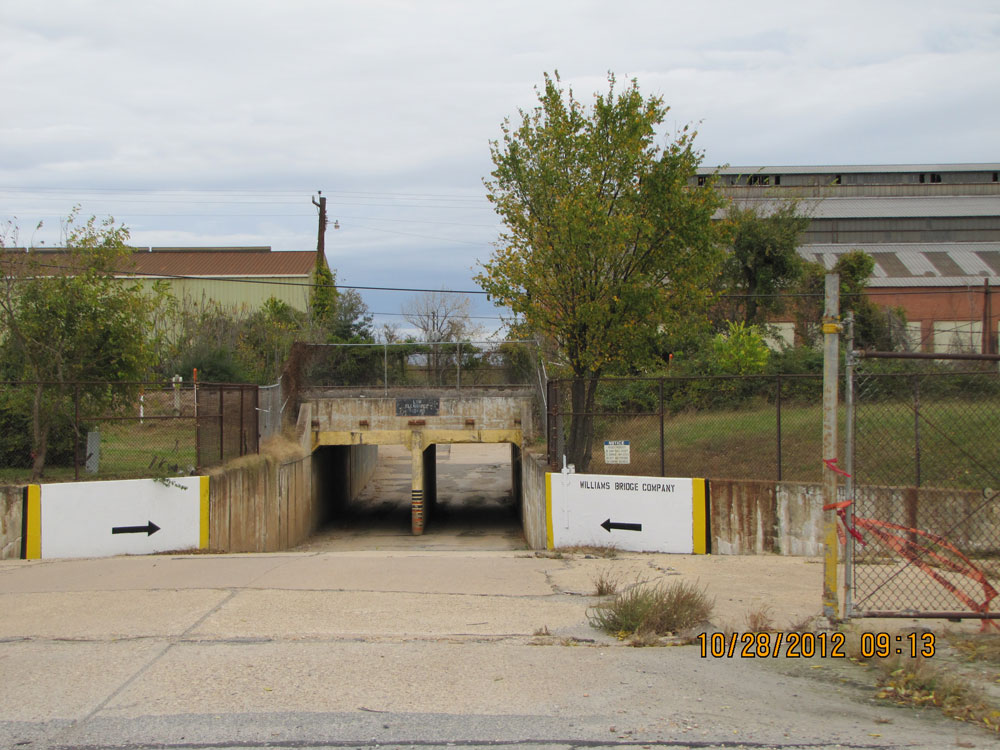
Taken June 14, 1960
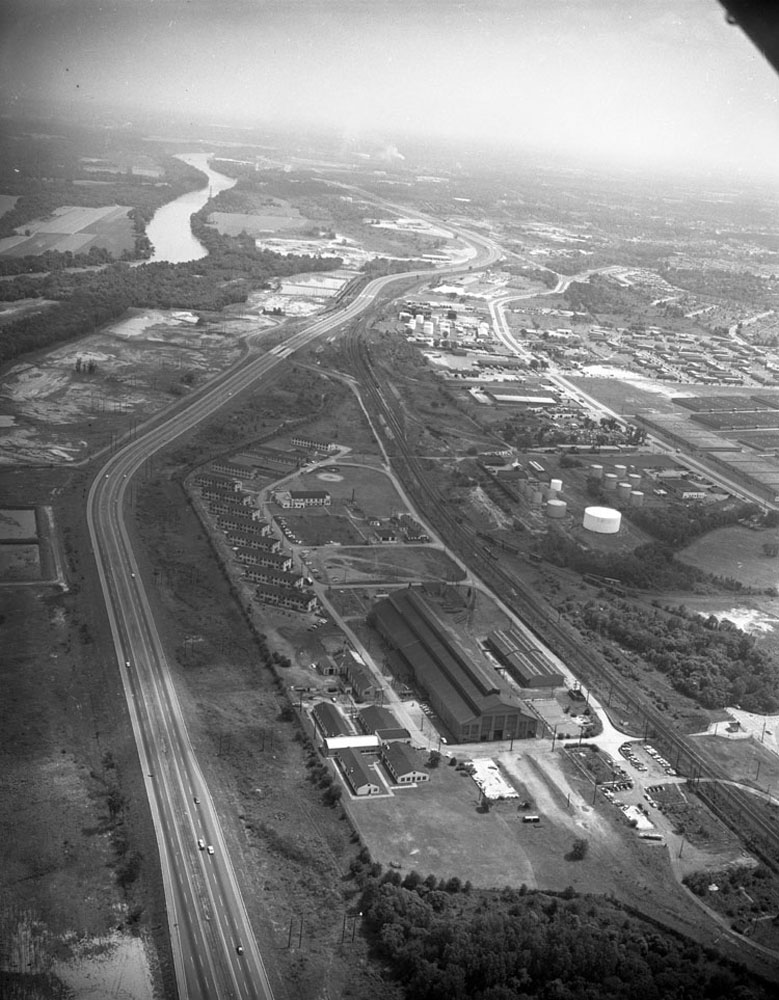
The old training School building (aka William Bridge Co. ) was purchased in November 2018 by the Steel Fabrication and Erection Division of Kinsley.
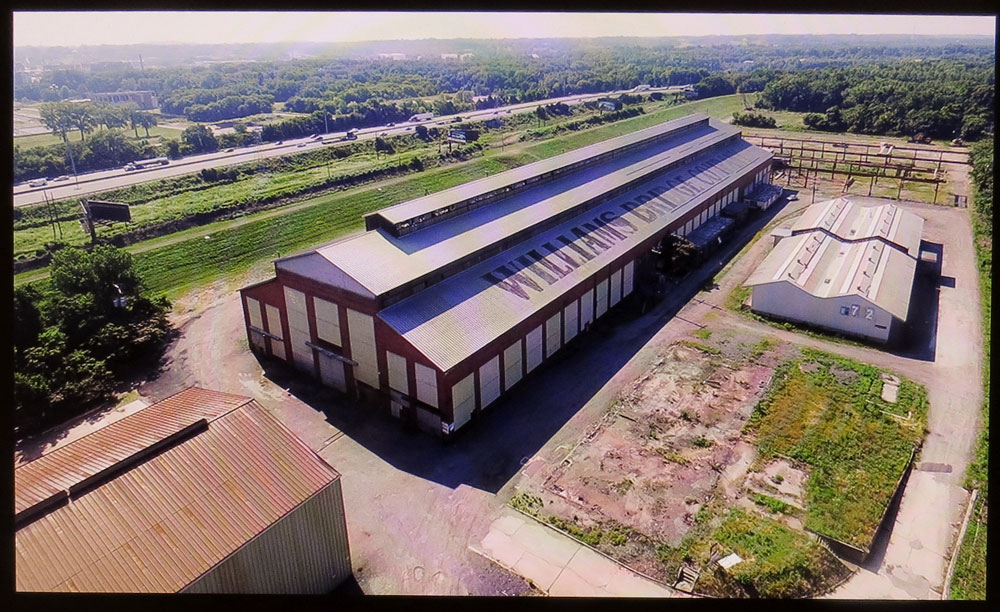
(Any information about any of the men
throughout this story would be appreciated)

After completing our training we were sent to Philadelphia, PA where we would check a daily list for deployment information.
I think it took about a week before my name appeared on the list . I was to go to Pier 92 in NYC and wait again for instructions. They came. My first ship was tied up at the Erie Basin in NY where I boarded as a "Fireman". I knew none of the men on the ship before that day.
It was the SC-1335 ( A Wooden Sub Chaser)
via an email from Captain Doyle's Grandson ( 01/24/19)
The ship's Captain was George A. Doyle
Executive Officer Lt. James McKay
My Dad purchased this picture from
Seaweed's Ships Histories in Sistersville, WV
The SC1335 was
built by Thomas Knutson SB Corp Halesite, Long Island
The keel was laid 9/15/42 Launched 6/5/43 and Commissioned 8/12/43
The overall length was 110 ft it was powered by a 8-268-A diesel engine capable of 15.6 knots and it's maximum draft with full load about 6 ft
It was no more than a cork on the ocean.
We raised anchor and started out to sea. Most of us were "green"( no real knowledge) and most of us were "green" (sea sick). Most of us had never been on the ocean before.
As I remember we made a quick stop at an island in the harbor to pick up munitions, then up the coast on a "Shake down" run to Boston, MA. From there we cruised north to Nova Scotia.
Our trip uncovered small problems that we quickly addressed. We turned and headed south, stopping briefly in Bermuda. Then proceeded to Miami, FL to training school. This is where we would learn how to use our 3" gun, mouse traps, K guns and depth charges. We practiced using our American submarines in the Florida Keys. Our ship was very fast capable of over 15 knots. Often we would travel as an escort. Sometimes with transport ships carrying rail cars to Havana, Cuba.
|
Here is the SC-1336 off the Florida Keys. I read that it was damaged by a coastal gun in the Mariana's on July 21, 1944 |
|
The Harbor in Cuba |
|
The Castle on Cuba |
After training our Captain was given orders to get to Norfolk, VA..
On our way up the coast we got caught in a major hurricane. Our ship was battered by high seas and tremendous winds. We all felt our Captain was nuts. He drove right into the storm even though the Coast Guard repeatedly flashed signal lights telling us to head for safer waters. All the way up the coast our Captain pushed on into the raging storm. His orders were to get to Norfolk. He risked everything and all of us to do it. We thought surely we were going to die. Die for no reason. The ship moaned from the stress on her wooden hull. We were tossed around and slammed into by huge waves. The bilge pump located in the bow became plugged from the entire supply of ground coffee, that had toppled over and was floating in the seawater that was flooding in. I assigned a man to stay in the bow and constantly clear the pump of the coffee grounds as they were being sucked up into the pump. Without the bilge pump working we would have sunk for sure. Bunks were torn loose. Rivets popped from everything. Lockers contents were dumped out. The swells were so large all we saw was a black wall of water all around us. The Atlantic Ocean is very frightening when she decides to release her fury. Every one of us was sea sick.( Except maybe our Captain). All we could do was lay in our bunks, hold on and pray.
The storm did severe damage to our little ship. It ended up in dry dock for about ten days while it under went the needed repairs.
Since we survived the hurricane and got to Norfolk
on time there was no questions about our Captain's
judgment. All of us knew now that we had a risk taker at the helm. We prayed he
would not put us in unnecessary danger. And he didn't. He would be a good and
fair
Captain.
![]() The
email from Captain Doyle's Grandson
The
email from Captain Doyle's Grandson
Hello,
I recently found your webpage on Robert Angell's military service
while conducting some online research about my grandfather George A
Doyle, who also served in the U.S. Navy in WWII. In fact, George was
the Captain of the SC-1335, the ship that Robert served aboard.
The story of the storm has been told many times at family gatherings
and it was amazing to read about it from the words of one of the crew
and have more details. It is heartening to know that my grandpa was
describes as a "good and fair Captain," despite leading them through
that terrifying ordeal. Finding your site was a real joy to me, since
my grandfather died when I was young and I had such a limited time to
hear his stories. Thank you.
George's four children are still living and I will reach out to them
to see if they have any information or pictures to contribute.
Sincerely,
Brian Doyle Plonsky
Once sea worthy we joined a convoy of 110 ships headed for Africa. It would be a long 4,000 plus mile trip across the ocean. We could only travel as fast as our slowest ship.
Bow of the SC-1335
This picture shows our weapons on the bow. We had two Mouse Traps ( sometimes referred to as "Hedge Hogs") & 3" Gun We also had 3- 20 mm canons on the rear deck. K guns on the port and starboard sides and one on the rear for launching the depth charges.
Refueling at sea was always a difficult operation. Things like the roll of the waves trying to crush us against the huge tankers or not having the right adapters for our tanks. We would have to refuel I think 4 times on this trip.
One of those times we were given the wrong type of fuel. A huge oil slick would be seen by air for many miles so not to draw attention to the rest of the fleet our orders were to wait until dark to pump the fuel into the sea. The convoy slowly disappeared over the horizon leaving us alone. Dead in the water like a sitting duck. We waited till night fall & pumped the fuel overboard. Cleaned the engine and the filters and got underway with our reserve fuel.
Once we caught up to the convoy we traveled with it to Casa Blanca, Morocco. Our assignment would be to patrol off the coast of Africa & the Canary Islands in search of the illusive German Submarine. When running in groups the German U-boats were known as "Wolf Packs".
Our living conditions onboard were tight. There was 24 men and 3 officers on our ship. We had a double row of 2 high bunk beds on the starboard side in the bow, under the 3" gun for 18 men. The remainder of the bunks where in the stern. Except for the Officers and the Captain who had separate quarters. Each of us had a small locker. The "Galley" was located port side with a table running down the middle.
The only fresh water we had came from a drinking fountain. There was no shower on board our ship. We would catch rain water for all fresh water needs. Sometimes I would grab a bar of soap and take a shower in the rain. To clean my clothes, I would wash them in a bucket. Some of the guys tied their clothes to a rope and dunked them in the ocean.
I was on the ship until its transfer on 11/12/43.
I have tried to research what happened to the SC-1335 after that, but I could not find any records on it after it was transfer to the French. I am still hopeful someone will know more.
![]() Another email from Brian:
Another email from Brian:
Hi MaryAnn,
Feel free to put in my grandpa's name in the story, as well as my email if you'd like.
It helps me feel closer to my family as well, having more information.
I've attached a few Muster Rolls that name all of the crew members of the SC-1335 from August to November 1943, as well as the signature pages naming my grandfather as commanding officer as well as Lt. James McKay as the executive officer. Additionally, I believe that the french officer that the ship was transferred to was named Jean Charles Devin du Fontenay once they arrived in Casablanca.
As I collect more information and pictures of this ship, its story, and anything about the crew I'l pass it along to you. If you have any more pictures of the ship, I would love to see them.
Best regards,
Brian
Muster Rolls for the SC -1335
October 1943: Crew

It is hard to read so here are the names: If anyone recognizes anyone please contact me if you would like to add to Dad's time line.
Angell, Robert J -
Bledsoe, Maxie L -
Bradford, Richard L -
Brown, Harvey M -
Buchanan, Robert W -
Casson, Walter J Jr. -
Daniels, William E -
Ebert, Albert H -
Egan, John J -
Farmer, Aaron C -
Greenwood, Carl L -
Manson, Howard H -
Heathman, William L -
Heinbaugh, James Alvin -
Lambaise, John E -
Lentz, Frank Anthony -
Linder, James P -
MacDonald, William F -
Means, Donald W -
Olivares, Arthur J -
O'Neill, James C -
Pond, Eugene E -
Schmaltz, Frank Jr. -
Whitman, Bennie L -



I was then assigned to the wooden sub chaser SC-516.
This is the crew of the SC-516 They were being sent home and we were the replacements.
(Standing first row on the right is Chief Boatswain's Mate Lee Bruce Hill)
Received an email from Lee Bruce Hill's Son on May 6,2008. He recognized his Dad in this photo He writes as follows
"Angel,
Thank you for the very
moving story of your Dad,
Robert
J. Angell, "Bob",
on the Custom Classic Construction website.
After viewing it , here is my message to my own children:
I was looking up Dad's third WWII ship, the USS Casa Grande, LSD-13, and thought I'd also look up the naval craft to which he was assigned before the Casa Grande. I found it, the SC 516 (sub-chaser).
Look at the last CPO (BMC) on the right end of the first row of those standing. That is Dad, then Chief Boatswain's Mate Lee Bruce Hill, at age 32. He had been a CPO since the summer of 1941. As the leading CPO, he stood bridge watch on the SC 516 in the role usually performed by a Commissioned Officer. (There were only two commissioned officers aboard at the time.)
His service aboard this small craft, along with his 15 years of service as of 1944 , led to his appointment as a Warrant Officer by order of President Franklin Delano Roosevelt, and subsequent assignment to the LSD-13* as Warrant Boatswain while she was still under construction.
There's more, much more..... :
http://en.wikipedia.org/wiki/USS_Casa_Grande_(LSD-13)
Dad served aboard the Casa Grande from her commissioning in 1944 through her decommissioning in 1946. I was twice aboard with him as the ship was moved about the Norfolk area the summer of 1946. Quite an adventure for an 11 year-old TN mountain lad !
Further info re: Dad. He served as a USN regular from 1929-1958, and retired as a Chief Warrant Officer, W-3. Of his 29 years of service, 25 were on sea duty, and only 4 on shore duty.
He passed away in 1978, 20 years after his retirement from the US Navy. He served in every theatre of WWII and was in 3 battles in the Pacific Theatre. Subsequently, he was in 2 battles in the Korean conflict.
I have have contact via e-mail with one of the sailors whom he commanded in the 1950's during his last sea service. His comment: "Mr. Hill was a firm but fair officer."
Angel, I thank you once again."
5/08/08
" Richard Lee Hill writes:
I appreciate your response, MaryAnn.
Here's some additional info re: the SC 516. The following is the best of my recollection 65 years later.
(I am 73, and have a slight service connected hearing disability from my time in the US Army....yes, the "other" branch of service ! )
The SC 516 patrolled the Caribbean in search of German subs before she was dispatched to North Africa. They were "home-ported" in Miami and New Orleans. My Mother stayed in those ports while Dad was at sea in the Caribbean. I have a photo of Dad taken in Trinidad.
He had a full "sailor's beard", and looked quite debonaire in his CPO uniform. When Dad first came ashore in his beard, Mother said she did not recognize him. She later told me that he and others so bearded in the crew "looked like pirates".
As you see in the photo of the crew in N. Africa, their uniforms were a mixed lot. Given the circumstances, they probably were glad to have any uniform to wear.
The SC 516 arrived in the N. African theatre about two weeks after Gen. Patton's landing. They were at Fedala, Casablanca, and thence into the Med. Sea, where they patrolled for German subs, and thus protected the groups of US ships that were bombarding the enemy and landing US troops. My Dad may have remained on the SC 516 after your Dad came aboard, because Dad told us about the SC 516 being handed over to the Free French Navy.
Photos taken in the N. African theatre show SC 516 crew members armed with .45 cal. pistols in shoulder holsters. There is one of the "skipper" holding a .45 cal Thompson sub-machine gun. Their metal helmets were of the World War 1 design, like those worn by British troops in WW I and WW II.
Though Dad never mentioned why they were so armed, in more recent years I have reasoned that since there were no Marines assigned aboard an SC, should they have captured a German sub and would have had to board it, the SC's crew would have served in that role. (At least from this soldier's point of view.)
They were indeed "The Greatest Generation".
Richard Lee Hill
Veteran , US Army, Korean Era
Consulting Engineer and Professor, retired "
Click on Images to Enlarge
|
Here I am with one of my shipmates on shore leave in Morocco |
Brown MM 2/C & Richard Lebaron Bradford E 1/C Both from the old crew of the SC-516 received word from Diane Bradford on 3/18/06. She recognized her Dad's picture, emailed me with his first and middle name. Diane also told me that her Dad passed away in February of 1982. |
Once, I remember when we were cruising alone a US Destroyer was readying her guns on us.
You see the Wooden Sub Chaser on the horizon looks very much like a U-Boat on the surface. Thankfully we had the days current codes and our radio man sent them quickly. We were at the mercy of the destroyer until it recognized our transmission and took it's guns off of us.
The Navy installed two brand new types of technologies on board called "Sonar" & "Radar". Neither one really ever worked well and if something broke there were usually no spare parts to repair them with. Since this "new" equipment was not very reliable We took no chances and would drop depth charges whenever there was a "Sounding".
A depth charge explosion
When General Quarters were called everyone had a specific position to report to. Everyone participation was critical in offensive operations. There was four of us assigned to the engine room. We couldn't see what was going on above, just feel and hear the sound of the explosions. Sometimes I would just sit and shake.
The 3" gun required 6 men to operate it. The K-guns needed 2 men and we had one on each side of the ship. The mouse traps would need several men. There were no extra people on board. Every one had a job to do.
I think all a German Sub Commander would have really had to do is, surface, get a bead on us with it's 4" gun, and that would have been the end of us. Tooth picks, splinters of wood, would be all that was left. We were very a lucky crew .The Atlantic Ocean tried and no U-boats ever had an opportunity to send us to a watery grave. Yes we were a very lucky crew indeed.
Once we had a collision with a huge fish. It looked like a whale to me but some of my shipmates referred to is as a "Black Fish" We were shaken and bent the screw. We limped back to port for repairs. He escaped with a huge scrape down his back.
We continued to patrol the African coast and escort ships until the SC-516 was transferred to the French on March 19,1944. As I would learn much later on, many of our ships were given to the French before the invasion. Maybe one or both of the SC's I was on are still around. I don't know.
I don't know what happened to the men I served with, we were all sent to different ships. Sadly I can't even remember their names any more.
Sub Chasers were dubbed the "work horse" of the Navy during WWII. They were assigned to jobs like escorting slower vessels and suppressing the German U-boat threat. Although they were the smallest commissioned craft in the Navy they saw action in every combat theater world-wide and often operated under extremely hazardous conditions. The Navy and the world were very close to forgetting these ships ever went to war.
Thanks to a few, the memory of these ships and their crews will be remembered.
"The Splinter Fleet" by Ted R. Treadwell
(Very informative with lots of pictures of SC's)
J. Meyers is sending us a DVD copy of some of the original blueprints in hopes of finding the SC-1335 or the SC516 among them
Chapter #2
My next assignment was the AV-5 Albemarle.
A seaplane tender.
After boarding her I never got sea sick again. The AV-5 was over 527' long. and was made of steel. She dealt with the Atlantic Ocean and the ill tempered weather that it would throw at us much better than the SC's.
Unlike the SC's we had everything. Plenty of fresh hot water for showering. We had a laundry room. You could get a Coca Cola or an ice cream bar out of a vending machine (something unheard of aboard the SC's.) This was a totally different experience. This was more like a floating village.
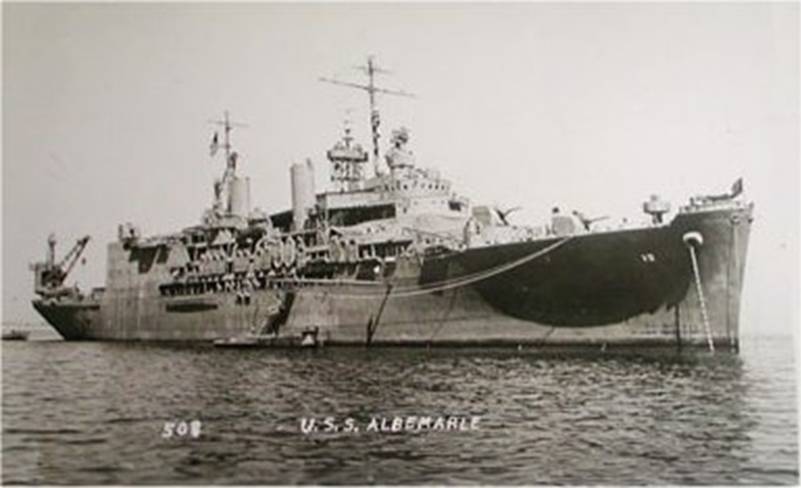
My Dad purchased this picture from
Seaweed's Ships Histories in Sistersville, WV
Built by New York SB
Keel laid 6/12/1939 Launched 7/13/1940 Commissioned on 12/20/1940
Speed 20 Kts
The Albemarle survived WWII
According to navel records she would be modified to support the "Seamaster" Flying boat 1956-57. Decommissioned to reserve 1960 (Date?) Stricken for disposal 9/1/1962 but never sold. On the Navy vessels register she was re-instated 8/1984 and converted at Charleston Navy Yard as a Helicopter repair ship to support US Army helicopters in Vietnam. She was renamed "Corpus Christi Bay" re-designated ARVH1 and place in service 3/27/1965.
One of my duties while on the Albemarle was to bring meals to a captured German Officer that was being shipped back to the states or possibly Canada. I wonder today if he was off the U- Boat U-505 that was taken by our Navy. Today the U-505 is a Museum in Chicago.
A little research came up with the following data on The U-505
 On June 4,1944 the CVE Guadalcanal with
Captain Dan Gallery in command along with his 4- destroyer group, surprised the
U-505 150 miles due west of Cape Blanco, French West Africa. The boat with it's specialized torpedoes and whatever German naval secrets that
may have been on board was a great catch but an Enigma machine & current code
books were also seized. Although the US had "Ultra" and was already reading
operational U-boat traffic. The Germans did not know this. The U-505 was towed
to Bermuda. The crew would be held there until the war ended.
On June 4,1944 the CVE Guadalcanal with
Captain Dan Gallery in command along with his 4- destroyer group, surprised the
U-505 150 miles due west of Cape Blanco, French West Africa. The boat with it's specialized torpedoes and whatever German naval secrets that
may have been on board was a great catch but an Enigma machine & current code
books were also seized. Although the US had "Ultra" and was already reading
operational U-boat traffic. The Germans did not know this. The U-505 was towed
to Bermuda. The crew would be held there until the war ended.
Not one sailor aboard any of the US ships involved told the tale of the first U-boat taken. They each pledged to not say anything to jeopardize the war effort. And they didn't. It was kept a secret until the end of the war.
After it's capture
I read somewhere that the Officers were sent to the states but I can't verify this.
I have ordered the book
"TWENTY MILLION TONS UNDER THE SEA"
By
Daniel V. Gallery
Maybe I will know more after I read it.
The Marine's were in charge of the prisoner. I was not allowed talk to him at all. I never heard his name or how we came to have him on our ship. So I am not sure if he was part of the U-505 but the time frame makes it possible.
June 6,1944 our forces invaded France.
We landed at Norfolk, VA. Then headed up the coast to Lido Beach on Long Island in NY. I was given a 30 day leave. I jumped on a train and headed home. It had been about 1-1/2 years since I had seen my parents.
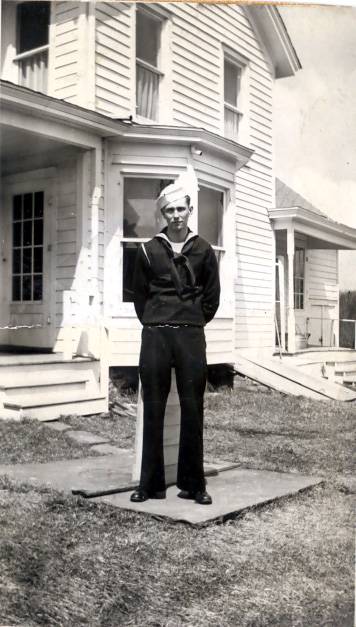
Here I am at my parents home on Brandle Road in Altamont, NY while on leave in June of 1944
After my 30 days I returned to Lido Beach Naval Base and received new orders. The navy had decided to send me back to school in Richmond, VA. I was going to learn how to repair and maintain diesel engines.
I graduated with the rank MOMM 2/C.
During our training we worked on the engines that came off the Submarine USS Squalus. It sunk off the coast of Portsmouth, New Hampshire on May 23, 1939.
A group of very brave men who risked their lives A true story of 113 days of the first use of oxygen helium for deep diving in the open sea. The rescue of 32 of her crew along with a civilian.
To read about the Squalus follow this link
The sinking of the USS Squalus
The engines were Diesel-Busch Sulzer's
Their design made them worked the same way as the Harley Davidson engine.
A V-twin at a 45 degree angle with a split cam.
For more information on the
Diesel-Busch Sulzer Diesel engine
From Richmond my next stop was the Net & Fuel Depot in Melville, RI. While waiting for our ship to be built we were schooled on how to run, maintain and repair the specialized equipment it would have.
We received word to board our ship the USS Naubuc a Net Tender, in New Orleans. She would be coming from Duluth, Minnesota via Lake Superior, down the Mississippi River to meet us there. The engines would be my responsibility.
This is when I first met Streeter. He was from Chicago. We boarded a train that took us first to Chicago then to Cincinnati, OH. In Cincinnati we had a 9 hour lay over.
A few of us took a train across the river to Kentucky to a place called the "Primrose Casino".
I will never forget the name. It was a wild place. Flashy, trashy and glamorous. The Las Vegas of the east coast. Gangsters ran the brothels & casinos. The billboards attracted famous Big Band names and dancers like Gypsy Rose Lee. We had a grand time. Drank a few beers, grabbed a bite to eat, saw a show and made it back across the river in time to catch our train.
From Cincinnati our train took us to New Orleans where we waited for
our Net Tender to arrive
Chapter #3
The USS Naubuc
commissioned March 1945
Click on Images to Enlarge
|
I don't remember who gave me this picture in 1944 Here is the AN-84 on Lake Superior with our Captain |
|
The Cairo "The Pusher"
|
The Nuabuc almost sank in Lake Superior from defective hatch covers. They leaked so badly she had to be brought down the river via a "Pusher" called Cairo. All the While her pumps ran constantly to rid her of the waters she was taking on. When she reached New Orleans much work was needed to get her seaworthy again.
That was the end of November 1944
This is the ship I would serve on for the remainder of my time at sea
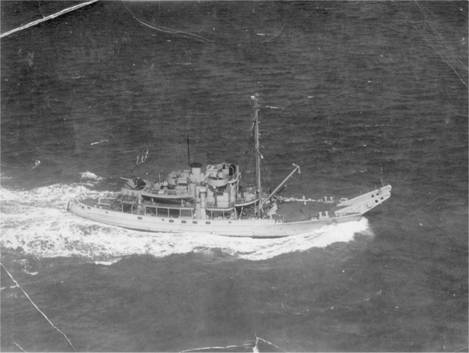
I borrowed this photo from the Navy archives. I didn't think they would mind
I can't believe I don't have a full view picture of my own to show you.
NET TENDER
168'-6" speed 12.3 Kts.
Powered by diesel electric, 2,500 hp motor
(ours had a 4-blade screw most had only 3)
Our first assignment was to work on the Mississippi River with two Navy Seal divers that were being re-qualified. The Mississippi is murky dirty water but where it meets the golf of Mexico the water is clear and clean. Like a line drawn across it.
After the re-qualifications were completed we raised anchor and headed for the Panama Canal. A sailor whose civilian job was an assistant coach to a Washington college football team was catching a ride home and would travel with us to the west coast.
The trip through the canal was uneventful.
|
The Panama Canal |
Waiting our turn to enter a lock |
||
|
A Control Tower
|
Lowered to exit level
|
||
|
Leaving the Lock
|
We pumped fresh water from the huge lake in the canal to wash the ship down. It would require our consistent attention to keep the seawater from damaging our specialized equipment. There was always work to be done.
We turned north and spent that Christmas (12/25/44) in "Salina Cruz" in the Golf of Towanapek Mexico. In Mexico part of the celebration involves throwing firecrackers. One was tossed in the open window and just missed me as I sat at the table. A group us took a bus ride on part of the North to South American Highway. I can't remember if that is what is it called but I have seen programs that talk about it on PBS in recent years. We visited a few local spots Drank warm beer and returned to our ship.
I was amazed at the number of sea turtles we saw. They were everywhere. As our ship would approach they would duck under water and resurface a few yards away. They continued their migration following their instincts. They didn't seemed to be bothered by us.
We traveled along the coast heading north to the US Naval Station at Long Beach.
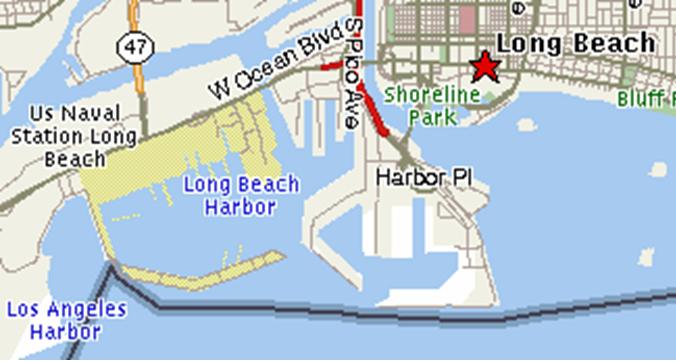
|
A Net Tender being repaired in Dry Dock |
Stern Showing our armament |
|
The Bridge |
The 422 "The Mayo" |
|
Miles of netting to keep Subs from entering the bay unnoticed |
That's me taking on a break |
|
The Bay Bridge |
Here I am with my friend "Streeter" |
We continued up the coast to San Francisco and spent New Years (1/1/45) there
Here are some of the crew on the AN-84
Do you recognize any of these men? Please let me know if you do.
|
|
||||
|
Duck & Radosevich
|
Flynn
|
|||
|
Our Engineering Officer in the Middle |
||||
|
Smith The cook
|
Fooling around (for the photo) We are going to chop up and throw the Captains sail boat over board. Our captain loved that little sail boat.
That's Flynn he was from Freeport Long Island, Me and I can't remember his name but I remember he was from Cairo, NY.
One time when Flynn was being tested we hid and gave him the answers. He scored very well on that test and received his new rank. It wasn't that Flynn didn't know the answers he just panicked when it was time to take the test.
The ships mascot
I don't remember his name. We might have put him on board in New Orleans. He was a good dog.
North of San Francisco we traded cigarettes and supplies for fresh Salmon being caught by local fishermen. In fact we had so much salmon we were sick of it by the time it was all eaten. Which was true of most of the food on board. Variety in our diet was not a priority to the Navy. We got what ever they had a lot of. And we ate a lot of fried bologna, chipped beef and lamb. I never did developed a taste for lamb.
We received new orders.
We were to cruise to Honolulu, Hawaii.
Shortly after we got under way that evening. I was given an "All Stop" on the engines. It seems we had hit an unlit civilian sail boat. The Coast Guard was called. We waited for them to arrive. Thankfully no one was injured. During the war years civilian boats were not supposed to be cruising after nightfall because of the danger of running into the enemy, which where known to come in close to our beaches after dark.
No fancy laundry on our ship. No soda or candy machines, like we had on the Albemarle. Although if our officers had ice cream on our Net Tender, Streeter saw to it that we were all equals in some things. I would even grab an orange from the bowl on the officers table every now and then. Never could figure out why they deserved better food than the rest of us.
Streeter had figured out that all a sailor had to do was fold back a metal flap covering the screw. He carefully unscrewed the latch leaving the lock intact. He would raid the pantry cooler at will. No need to break the lock. He never got caught and they never figured out how it was done,
Main deck had the kitchen on the starboard side and the mess hall ran to the stern. The shower was port side with a ladder leading to the engine room. In the bow was a bulk head and cargo.
The Officers ate and slept below the bridge in the bow.
Mid level starting at the stern (port side) was the Ladder to the engine room (.I kept a secret parts crate in the engine room to stow extra dungarees and stuff in.) My bunk was starboard side. (bottom bunk second row of three) My dress uniform I kept under my mattress It did a good job of keeping it pressed. In front of the bunks was the hold.
The sub level held the pantry and meat locker to the rear along with the "Chef's quarters". Under the port side bunks was the magazine,( The ammo) In front of that a bulk head, oil tanks and more cargo in the bow.
I don't remember any fights or major upheaval. We all seemed to get along and understand how much we needed each other if we were going to survive.
Supplies and parts were not always easy to come by We traded and bartered with other ships when we could. You rarely had all the right parts. Neither did anyone else. The ships filters needed cleaning almost perpetually. Shutting down the engines even for short periods left you vulnerable. We worked on 4 hour shifts with a 2 hour rotation.
We had two colored sailors on our ship. One of them I believe was from Chicago. He was a tremendous artist. I was very impressed with his ability to sketch. I wish I had kept a few of them to show you now. He would draw anything you asked him to and they were very realistic. I would learn later on different branches of the military separated the Blacks from Whites. We all lived and worked side by side. They were Americans serving their country just like the rest of us. I believe we were all treated the same on our ship.
Across the Pacific to Pearl we traveled. The Navy had set up huge fresh water holding tanks at strategic places in the ocean. We filled up as we needed.
Entering the harbor we were all horrified. The Arizona was a spine chilling sight. It had been almost 4 years since the Japanese bombed Pearl. Each of us remembered exactly where we were when we heard the news. The devastation was still evident.
We were there for only two days with no leave. I had to over haul one cylinder of our engine. This was routine to ensure our engines would always be at peak performance.
While in Pearl "Streeter" our electrician saw his old ship the DE-422 ( The Mayo") in port.
The "Mayo" had escorted the Albemarle several times in the Atlantic. (Streeter and I didn't know each other then.) When we left Honolulu it would be the last time I would see a sailor in "Dress Whites' for a very long time.
Our new assignment would send us southwest passed the international date line to
The Marshall & Caroline Islands.
Strong hold of the Japanese Military.
We headed deep into Japanese territory. They had outposts and military control of many small strategic islands throughout the Pacific.
Our main forces that proceeded us ignored these islands figuring they would simply cut off the supply line. The Japanese on these islands still had their resolve and were very well armed.
In the Marshall Islands our job was to set a Mark-II mooring buoy off Eniwetok and one off Kaljalien for the Destroyers that would follow.
Since no maps or charts were available we had a shipmate lower a "lead line" ( pronounced LED... a rope with marks on it showing depth by fathoms) over the bow. When we were in waters the Destroyers could safely moor we would set a Mark II buoy.
|
Burning anchor chains from Mark- II That's Liston and Smith |
|
|
| Laying the Mark- II buoy... Smith, Armstrong, Freeman and McCluckie |
|
|
The destroyers job would be to deal with the Japanese military that were on the islands. There were thousands of them and only a few of us. They could have easily swam out, killed us and taken our ship but they didn't. We keep a watchful eye on the islands taking no chances. Got our mooring buoys set and moved on to the next assignment. They were dug in so deep on these islands. We never even saw one of them.
The Caroline Islands
|
Set Mooring buoy at Ponape for the DE 766 The USS SLATER It is now a Museum in the port at Albany, NY |
|
The island in the distance is Kosrae
|
|
Thousands of Japanese on this island and very well hidden from our view. |
We set a Mark II buoy at Ponape and at Kosrae
The Caroline's had among its chain of islands one of the largest Military supply base for the Japanese. It was on Truk. Fortunately we were not ordered to go there. Our Main forces were dealing with Truk
The closest we would get to the equator was 5 degrees.
If I was Captain I would have crossed over just to have done it. When would we ever get that close again. Never as it turned out.
On some of the smaller islands and atols ( an atol is nothing more than a sandbar with a couple of palm trees on it)
We were allowed to go ashore to play football and have a beer sometimes. We sometimes were lucky enough to collect fruit to bring back to the ship. I collected seashells that I still have from those islands.
The waters in the pacific were different than those of the Atlantic. Shades of aquamarine around the islands so crystal clear you could see the bottom. We could see sharks, barracuda and rays swimming below and we still jumped in. Like all young men at the age of 21 we were invincible. We never heard of the movie "Jaws". Our big worry was staying out of the jaws of the Japanese not the fish swimming under us.
INSERT PICTURE
August 6, 1945 at 8:16AM The Atom Bomb was dropped on the city of Hiroshima, Japan codenamed "Little Boy" by B-29 Enola Gay
August 9, 1945 The Second Atom Bomb is dropped at 11:02 AM codenamed "Fat Man" on the city of Nagasaki, Japan by the B-29 Bockscar
The Japanese had deserted an outpost on one of the islands we went ashore on. We found horrible living conditions. I wouldn't even go inside the caves.
Trenches and tunnels all over the island full of rats. When they ran they left behind everything.
Some of my shipmates gathered souvenirs to take home.
Everything from guns and ammunition to uniforms was there for the taking if you were so inclined. It was hard to imagine anyone living under those conditions for months and months perhaps years. I guess my bunk on board was not such a bad place to live.
This island had a Banana Plantation on it Those bananas & coconuts were a real treat.

Chapter #4
The Japanese Surrender on September 2, 1945
We were ordered back to Pearl Harbor. This time we had shore leave. Once again I would see a White Uniform. and a woman.
|
My final Navy Training course and my new rank of Petty Officer 1st Class MOMM |
Our ship was ordered back to the states. We arrived in San Francisco December 1, 1945 (according to NavSource Online). It also says we completed a short tour back to the canal zone before we reported to San Diego on January 2, 1946 for duty with the 11th Naval District.
Points were earned by time served, good conduct, marital status, combat, rank and many other factors. Once you had enough you were eligible for discharge
I had earned my "points"
I had done my duty, served my time. NO I wasn't interested in signing up again, nor was I interested in joining the reserves. I wanted my papers letting me go home. I was more than ready.
We took the train (That was the main means of transportation in the 40's) Every family didn't have a car like today in fact I didn't have a driver's license at that point.
Our train ride had barely got under way when there was a very bad accident. The train I was on had hit a truck full of migrate workers and there was several fatalities. All that time in all those dangerous places and I am looking at more death on US soil than I ever saw at sea. Tragic.
The train weaved it way across the country. Stopping everywhere along the way. My destination was Lido Beach on Long Island where I would officially leave the United States Navy on February 28, 1946
My discharge papers
|
card for satisfactory Service in the US Navy |
|
|
|
The Navy (even though I protested) Checked off "Inducted" rather than the truth. I enlisted. I was a "Service Volunteer" |
|
Notice of Separation from U.S. Naval Service |
|
|
An Honorable Discharge
my original tag and chain you can even see where I had to repaired it a few times.
This Bronze sits on my mantle The LONE SAILOR a gift from a very good (EX- Navy) friend
Insert picture of display box of metals and ribbons
"I would come to regret not making an effort to keep in touch with the men I served with on all the ships I was on especially the AN-84. How nice it would be to talk to them now.
I wonder how their lives turned out." Bob
A year after I got home I met the most charming and beautiful woman.
She had served in the WAVES
(WAVES stands for Women Accepted for Volunteer Emergency Service)
Her name was Catherine, but that's a story for another day
WWI
This is my Paternal Great Uncle Robert ( My father's namesake)
This pictures was taken just before he was shipped out.
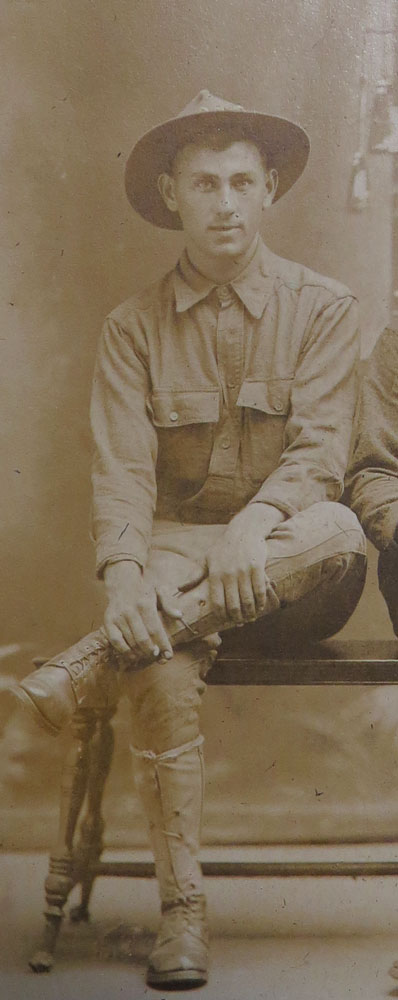
RIP Uncle Robert

This is a great video narrated by President Ronald Reagan . It will humble you down to your toes.
FREEDOM IS NOT FREE | A Soldier's Pledge

Robert died in World War I November 11th,1918 on the last day of the war a day
that would later become to be known as "Armistice Day " .
He was buried in Meuse-Argonne France .
My Dad told us the story many times as he held a small piece of the shrapnel
from that munition: The quick version is:
My
Great Uncle Robert and small group of soldiers had built a fire to warm
themselves and cook their first hot meals in weeks.
Robert
and 8 other men closest to the fire died when a failed munitions that was
buried out of sight under the spot they choose for the fire pit suddenly
exploded.
Since my Poppy was still
in Europe ( he was in the Army also) getting Robert home
fell to my Grandma.
She would not take no for an answer and was eventually given permission to made the arrangements and at the family's expense have Robert exhumed from Meuse-Argonne and shipped home where he was laid to rest in the family plot.
Rest in Peace Uncle Robert
Sadly my Dad passed away on April 28,2005
"I will not be making any more changes to this timeline unless someone contacts me and is willing to help me fill in some events within his service years. I want to thank everyone that has shown such interest in my Dad and his story."
I have received so many wonderful emails I wanted to share them with you in hopes you might recognize a shipmates name or a ship
( When you email me be sure to let me know if including your information on this site is ok with you
I will respect your privacy if you choose not to have the exposure)
May they never be forgotten.